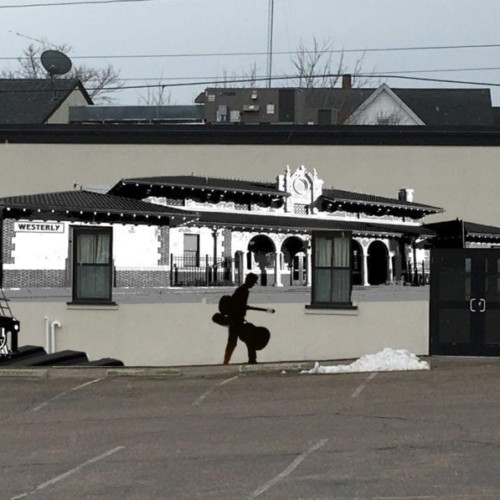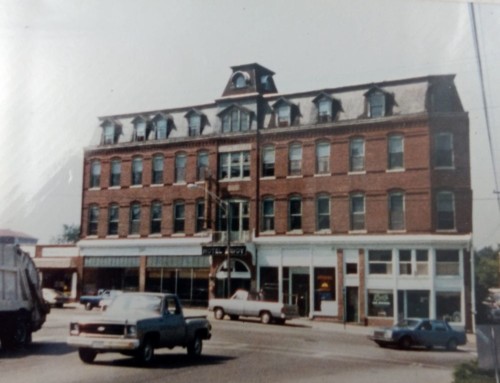The following is part 10 in Westerly Life’s “Behind the Murals” series discussing the history behind all of the recently created murals throughout downtown Westerly. In this story, we will be discussing two murals, the first is dedicated to the New York, New Haven and Hartford Railroad and can be seen from the Amtrak station in Westerly and the second mural celebrates the history of the Knickerbocker Music Center and can be found on the side of the Knickerbocker building.
It is often said that the railroad revolutionized transportation in the United States and when one considers the impact that trains have had on Westerly, this statement certainly appears to be true. Westerly’s first train station opened for business on November 10, 1837, and ever since the first train pulled out of the station, they’ve continued to run through the town for the more than 180 years.[1]
While the latest mural features a train operated by the New York, New Haven, and Hartford Railroad Company, Westerly’s history of train transportation began long before the company’s arrival in 1892. When the first Westerly station opened in 1837, it was incorporated into the newly built Stonington and Providence Railroad which ran between Hill’s Wharf in Providence and Stonington Village.[2]
For the first time, citizens of Westerly could easily travel to and from Providence with relative ease. In 1846, a direct line was established between Providence and Boston, allowing Westerly residents to now travel to Boston faster than ever before.[3] Despite the convenience these trains provided, they had a limited schedule, with only three passenger trains, one mail train, and one freight train leaving Westerly daily in 1857 (as compared to the 33 trains that stopped in Westerly daily by 1904).[4]
After 35 years of service, the original Westerly train station was closed, as a new station was opened in 1872. The original station was relocated and used as a freight facility.[5] 1889 was a crucial year for the railroad in Westerly, as the Thames River Railroad Bridge was completed, and thus, an all-rail link between Boston and New York City was completed.[6] This allowed Westerly residents to travel between the two cities and also made Westerly a hub for urban travelers.
In 1892, the Stonington and Providence Railroad was acquired by the New York, New Haven and Hartford Railroad.[7] The Railroad, commonly known as ‘the Consolidated’ or ‘the New Haven,’ was the dominant force in transportation through southern New England by the turn of the Twentieth Century.[8] In addition to controlling train travel between Boston and New York, the company also controlled most of the area’s steamships and streetcars.[9] The railroad’s ability to overtake its competition was due in large part to the financial support of one of its chief investors, J.P. Morgan.[10]
The Westerly station continued to serve as an important stop along the line between the area’s two largest metropolises, and for this reason, a new station was proposed for Westerly as early as 1899. It was not until 1911, however, that these plans came to fruition. The development of a new station on Railroad Avenue required several crucial steps which shaped the physical landscape of the town.
The 1911 plan proposed purchasing and removing all of the houses on Dixon Hill, reshaping the hill to the railroad grade, tearing down the Armour and Company Meat Packing building and constructing a new site on Canal Street, realigning Friendship Street further to the north, and doubling the size of the West and High Street bridges.[11] These proposals were accepted, and the station opened in 1913. When the station opened, the first customer was Col. A.E. Dick, a summer resident, and the manager of the Watch Hill House.[12]
The 1913 train station still stands on Railroad Avenue today, with relatively few changes over the last century. In 1950, the Leatherbee Company of Brookline, Massachusetts made an offer to purchase the station and transform it into retail space, but public outcry resulted in the railroad rejecting the offer in 1952.[13] In 1969, the Penn Central Railroad assumed ownership of the New Haven company and maintained the line through Westerly until 1976, when the United States Congress created Amtrak, which assumed ownership of all of Penn Central’s assets.[14] To this day, Amtrak holds ownership of the Westerly railroad station and operates several trains which run through the town every day.
Directly across from the railroad tracks, you’ll find the Knickerbocker Music Center, known locally as ‘The Knick.’ The music club, which opened in 1933, is said to be named for the Knickerbocker train, which ran through Westerly, right outside the club’s doors.[15] The only known train named the Knickerbocker which was operating in 1933 ran between New York City and Boston via Albany, and therefore, would not have passed through Westerly.[16] There was a train which ran from New York City to Boston via Providence in 1933 on the New Haven Railroad, however, this train was known as the Merchants Limited.[17]
Despite this, it is clear that the railroad had a big impact on the club, as train passengers disembarked on Railroad Avenue, with the club only yards away, making it a popular stop for visitors and locals alike. Over the years, the venue has hosted a number of popular Blues and Jazz musicians, including “Big Joe Turner, Albert Collins, Johnny Copeland, Johnny Nicholas, Leon Russell, Eric Burdon and Stevie Ray Vaughan.”[18] Read more about Stevie Ray Vaughan’s Shows at the Knickerbocker here.
Perhaps the most well-known band to play the Knick on a regular basis is Westerly’s own Roomful of Blues. Since forming in 1967, Roomful of Blues has seen a great deal of success, garnering five Grammy nominations and seven Blues Music Awards, including a victory in the Blues Band of the Year Category in 2005.[19]
The band maintained a consistent Sunday night gig at the Knickerbocker for many years, continuing to build their local and national fanbase.[20] Over the last five decades, the band has featured more than 50 different musicians and continues to bring new musicians into the fold, while garnering praise on the national blues scene.
According to Roomful of Blues founder Duke Robillard, the Knickerbocker was “the hip, trendy place to be.”[21] Duke also noted that because the club was close to both Watch Hill and Newport and that affluent visitors would hear about the club and make their way down to Westerly to catch a show.[22]
More recently, the Knickerbocker has shifted its focus, transforming into the Knickerbocker Music Center, partnering with the Rhode Island Philharmonic and Music School. In doing so, they have developed a mission to “preserve, cultivate and grow the “Knick’s” unique brand of blues, as well as expanding access to music of all genres, by transforming the Knick into both an exciting performance venue and an exceptional center for music education.”[23] Doing so allows the club to continue its tradition of outstanding music, while also helping to develop the musicians of tomorrow.
[su_accordion class=””] [su_spoiler title=”Footnotes” open=”no” style=”default” icon=”plus” anchor=”” class=””]
[1] William D. Warner, Architects and Planners, “Historical Evaluation Report: Westerly Train Station, Westerly, Rhode Island” (1995), pg. 2.
[2] William D. Warner, Architects and Planners, “Historical Evaluation Report: Westerly Train Station, Westerly, Rhode Island” (1995), pg. 2.
[3] William D. Warner, Architects and Planners, “Historical Evaluation Report: Westerly Train Station, Westerly, Rhode Island” (1995), pg. 2.
[4] William D. Warner, Architects and Planners, “Historical Evaluation Report: Westerly Train Station, Westerly, Rhode Island” (1995), pg. 9.
[5] William D. Warner, Architects and Planners, “Historical Evaluation Report: Westerly Train Station, Westerly, Rhode Island” (1995), pg. 2.
[6] William D. Warner, Architects and Planners, “Historical Evaluation Report: Westerly Train Station, Westerly, Rhode Island” (1995), pg. 2.
[7] William D. Warner, Architects and Planners, “Historical Evaluation Report: Westerly Train Station, Westerly, Rhode Island” (1995), pg. 2.
[8] Rhode Island Historic Resources Archive, West Street Railroad Bridge, RIHRA No. WESY-0005, pg. 4.
[9] Rhode Island Historic Resources Archive, West Street Railroad Bridge, RIHRA No. WESY-0005, pg. 4.
[10] Rhode Island Historic Resources Archive, West Street Railroad Bridge, RIHRA No. WESY-0005, pg. 4.
[11] William D. Warner, Architects and Planners, “Historical Evaluation Report: Westerly Train Station, Westerly, Rhode Island” (1995), pg. 11.
[12] William D. Warner, Architects and Planners, “Historical Evaluation Report: Westerly Train Station, Westerly, Rhode Island” (1995), pg. 12.
[13] William D. Warner, Architects and Planners, “Historical Evaluation Report: Westerly Train Station, Westerly, Rhode Island” (1995), pg. 13.
[14] William D. Warner, Architects and Planners, “Historical Evaluation Report: Westerly Train Station, Westerly, Rhode Island” (1995), pg. 13-14.
[15] “History” The Knickerbocker Music Center Website, https://knickmusic.com/knick-info/.
[16] New York Central Railroad, The Knickerbocker, Schedule, 1946, http://www.streamlinerschedules.com/concourse/track3/knickerbocker194603.html.
[17] New York, New Haven, and Hartford Railroad, The Merchants Limited, 1936, http://www.streamlinerschedules.com/concourse/track3/merchantsltd193302.html.
[18] “History” The Knickerbocker Music Center Website, https://knickmusic.com/knick-info/.
[19] Roomful of Blues Official Website, https://www.roomful.com/.
[20] “History” The Knickerbocker Music Center Website, https://knickmusic.com/knick-info/
[21] Tipaldi, Art, Children of the Blues: 49 Musicians Shaping a New Blues Tradition, (2002), pg. 212.
[22] Tipaldi, Art, Children of the Blues: 49 Musicians Shaping a New Blues Tradition, (2002), pg. 212.
[23] “History” The Knickerbocker Music Center Website, https://knickmusic.com/knick-info/
[/su_spoiler] [/su_accordion]








